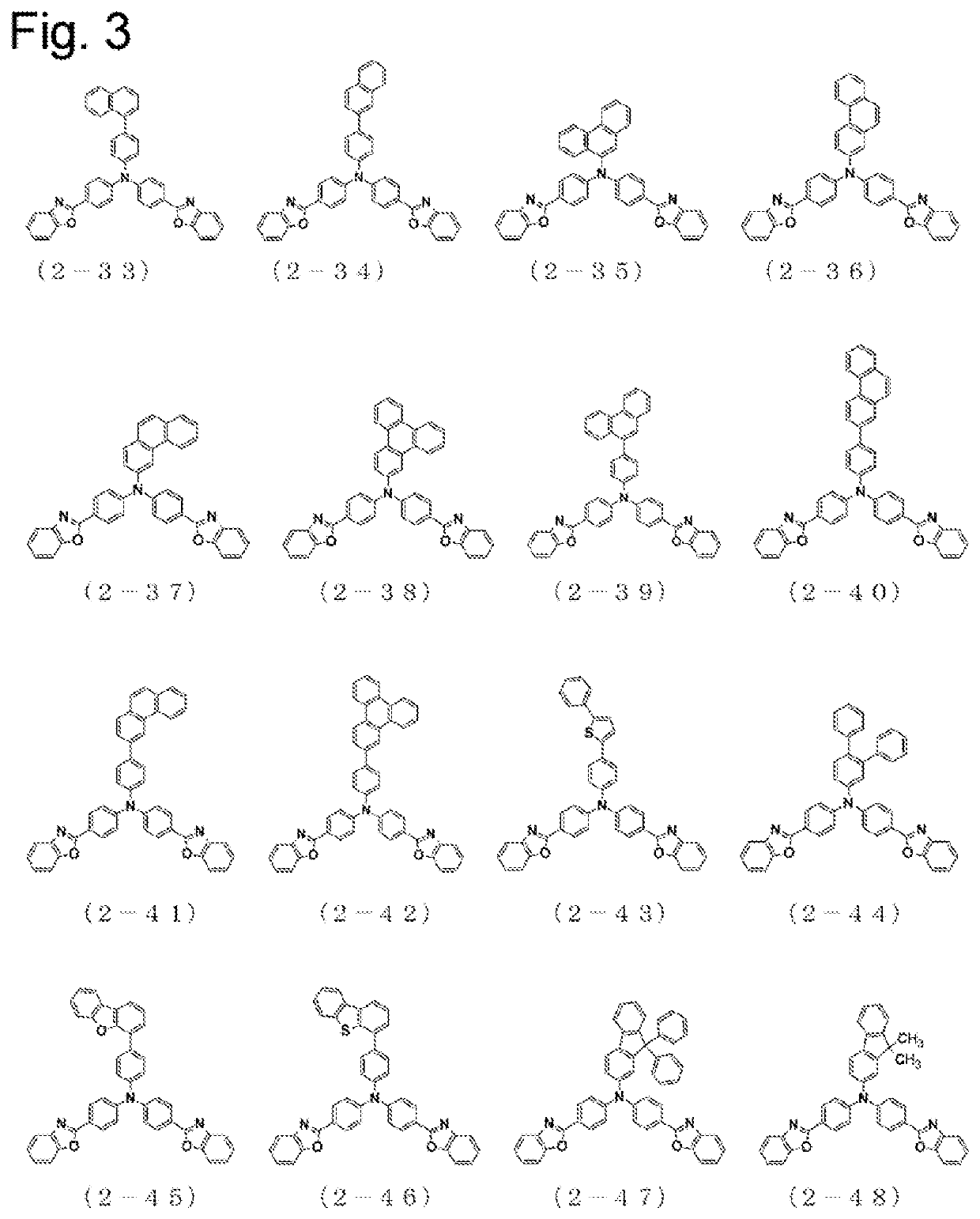Arylamine compound having benzoazole ring structure, and organic electroluminescent element
a technology of organic electroluminescent elements and benzoazole, which is applied in the direction of luminescent compositions, organic chemistry, chemistry apparatus and processes, etc., can solve the problems of poor color purity, limited area from which light can be extracted, poor light extraction efficiency, etc., to improve color purity and light extraction efficiency, and prevent damage to light-emitting devices.
- Summary
- Abstract
- Description
- Claims
- Application Information
AI Technical Summary
Benefits of technology
Problems solved by technology
Method used
Image
Examples
example 1
Synthesis of Bis-{4-(benzoxazol-2-yl)phenyl}-{4-(naphthalen-2-yl)phenyl}amine (2-34)
[0193]A reaction vessel was charged with 7.5 g of 4-(naphthalen-2-yl)phenyl-amine, 20.6 g of 2-(4-bromophenyl)benzoxazole, 9.9 g of sodium t-butoxide, and 150 ml of toluene, and was aerated with nitrogen gas for 30 minutes under ultrasonic irradiation. Then, 0.9 g of tris(dibenzylideneacetone)dipalladium(0) and 0.4 ml of a 50% (w / v) toluene solution of tri-(t-butyl)phosphine were added, and the mixture was stirred for 3 hours under reflux with heating. The mixture was left to cool to 80° C.; then, silica gel was added thereto and the mixture was filtrated. The filtrate was concentrated, to obtain a crude product. The crude product was recrystallized with toluene, to obtain 6.3 g of a yellow powder of bis-{4-(benzoxazol-2-yl)phenyl}-{4-(naphthalen-2-yl)phenyl}amine (2-34) (yield: 30%).
[0194]The structure of the obtained yellow powder was identified by NMR.
[0195]The following 27 hydrogen signals were d...
example 2
Synthesis of Bis-{4-(benzoxazol-2-yl)phenyl}-{4-(phenanthren-9-yl)phenyl}amine (2-39)
[0197]A reaction vessel was charged with 8.0 g of 4-(phenanthren-9-yl)phenyl-amine, 17.9 g of 2-(4-bromophenyl)benzoxazole, 8.6 g of sodium t-butoxide, and 160 ml of toluene, and was aerated with nitrogen gas for 30 minutes under ultrasonic irradiation. Then, 0.8 g of tris(dibenzylideneacetone)dipalladium(0) and 0.4 ml of a 50% (w / v) toluene solution of tri-(t-butyl)phosphine were added, and the mixture was stirred for 3 hours under reflux with heating. The mixture was left to cool to 80° C.; then, silica gel was added thereto and the mixture was filtrated. The filtrate was concentrated, to obtain a crude product. The crude product was recrystallized with toluene, to obtain 15.0 g of a yellow powder of bis-{4-(benzoxazol-2-yl)phenyl}-{4-(phenanthren-9-yl)phenyl}amine (2-39) (yield: 77.0%).
[0198]The structure of the obtained yellow powder was identified by NMR.
[0199]The following 29 hydrogen signals ...
example 3
Synthesis of Bis-{4-(benzoxazol-2-yl)phenyl}-([1,1′,2′,1″]terphenyl-4′-yl)-amine (2-44)
[0201]A reaction vessel was charged with 5.6 g of ([1,1′,2′,1″]terphenyl-4′-yl)-amine, 14.4 g of 2-(4-bromophenyl)benzoxazole, 4.4 g of sodium t-butoxide, and 60 ml of toluene, and was aerated with nitrogen gas for 30 minutes under ultrasonic irradiation. Then, 0.1 g of palladium acetate and 0.4 ml of a 50% (w / v) toluene solution of tri-(t-butyl)phosphine were added, and the mixture was stirred overnight under reflux with heating. The mixture was left to cool; then, methanol was added thereto, and the precipitated solid was collected, to obtain a crude product. The crude product was subjected to crystallization purification with a toluene / acetone mixed solvent, and the precipitated solid was collected, to obtain 11.0 g of a yellow powder of bis-{4-(benzoxazol-2-yl)phenyl}-([1,1′,2′,1″]terphenyl-4′-yl)-amine (2-44) (yield: 76.4%).
[0202]The structure of the obtained yellow powder was identified by N...
PUM
 Login to View More
Login to View More Abstract
Description
Claims
Application Information
 Login to View More
Login to View More - R&D
- Intellectual Property
- Life Sciences
- Materials
- Tech Scout
- Unparalleled Data Quality
- Higher Quality Content
- 60% Fewer Hallucinations
Browse by: Latest US Patents, China's latest patents, Technical Efficacy Thesaurus, Application Domain, Technology Topic, Popular Technical Reports.
© 2025 PatSnap. All rights reserved.Legal|Privacy policy|Modern Slavery Act Transparency Statement|Sitemap|About US| Contact US: help@patsnap.com



